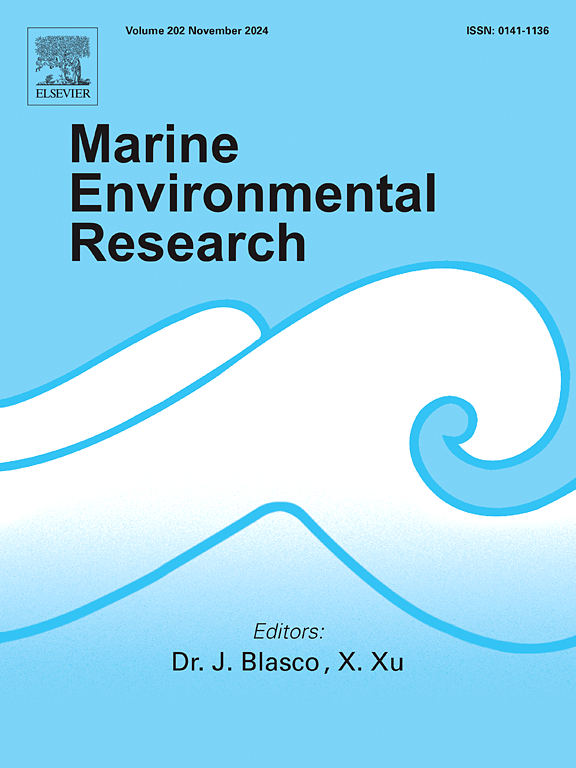Environmental DNA reveals how the absolute dominant zooplankton species affects the community
IF 3
3区 环境科学与生态学
Q2 ENVIRONMENTAL SCIENCES
引用次数: 0
Abstract
Zooplankton play a crucial role in marine ecosystems. In recent years, the East China Sea (ECS) has recorded the highest levels of pollution among China's marine areas, leading to a trend toward homogenization of the dominant zooplankton species. Environmental degradation has triggered various ecological responses, but how these responses further impact community structure requires more investigation. In this study, we employed a combined approach of morphological identification and environmental DNA (eDNA) metabarcoding to analyze the effects of seasonal variation and dominant species on zooplankton communities. The results indicated that an absolute dominant species, Calanus sinicus, emerged in the ECS, significantly occupying ecological resources. As seasons changed, C. sinicus showed a trend of migrating from offshore to coastal areas. The high abundance of C. sinicus in the sub-regions led to a regional decline in zooplankton community diversity and interspecies cooperation, while the community also experienced stronger dispersal limitations. Furthermore, the spring zooplankton community exhibited higher alpha and beta diversity, as well as a more stable co-occurrence network compared to summer. However, the level of interspecies cooperation in spring was lower than in summer. In conclusion, the high abundance of C. sinicus has a significant impact on zooplankton communities, and this impact shows a lag effect.

环境DNA揭示了绝对优势的浮游动物物种是如何影响群落的
浮游动物在海洋生态系统中起着至关重要的作用。近年来,东海是中国海洋污染最严重的海域,导致优势浮游动物物种呈同质化趋势。环境退化引发了各种生态反应,但这些反应如何进一步影响群落结构需要更多的研究。本研究采用形态鉴定和环境DNA元条形码相结合的方法,分析了季节变化和优势种对浮游动物群落的影响。结果表明,东南区出现了绝对优势种——黄颡鱼(Calanus sinicus),占据了大量生态资源。随着季节的变化,sinicus呈现出由近海向沿海迁移的趋势。不同区域中sinicus的高丰度导致了浮游动物群落多样性和种间合作的区域下降,同时也经历了更强的扩散限制。与夏季相比,春季浮游动物群落表现出更高的α和β多样性,并具有更稳定的共生网络。春季的种间合作水平低于夏季。综上所述,sinicus高丰度对浮游动物群落有显著影响,且这种影响呈现滞后效应。
本文章由计算机程序翻译,如有差异,请以英文原文为准。
求助全文
约1分钟内获得全文
求助全文
来源期刊

Marine environmental research
环境科学-毒理学
CiteScore
5.90
自引率
3.00%
发文量
217
审稿时长
46 days
期刊介绍:
Marine Environmental Research publishes original research papers on chemical, physical, and biological interactions in the oceans and coastal waters. The journal serves as a forum for new information on biology, chemistry, and toxicology and syntheses that advance understanding of marine environmental processes.
Submission of multidisciplinary studies is encouraged. Studies that utilize experimental approaches to clarify the roles of anthropogenic and natural causes of changes in marine ecosystems are especially welcome, as are those studies that represent new developments of a theoretical or conceptual aspect of marine science. All papers published in this journal are reviewed by qualified peers prior to acceptance and publication. Examples of topics considered to be appropriate for the journal include, but are not limited to, the following:
– The extent, persistence, and consequences of change and the recovery from such change in natural marine systems
– The biochemical, physiological, and ecological consequences of contaminants to marine organisms and ecosystems
– The biogeochemistry of naturally occurring and anthropogenic substances
– Models that describe and predict the above processes
– Monitoring studies, to the extent that their results provide new information on functional processes
– Methodological papers describing improved quantitative techniques for the marine sciences.
 求助内容:
求助内容: 应助结果提醒方式:
应助结果提醒方式:


